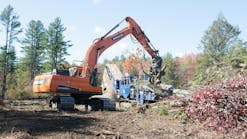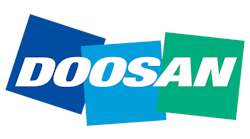“The DOT requires only using ‘active shoring’ devices, which means that the trench cannot be open at any time during the excavation, so traditional trench boxes are not an option,” says B.R.S. Project Superintendent Roger Kimrey. B.R.S. consulted with local distributor Stafford Equipment and Efficiency Production Inc. to design and develop the shoring system.
In order to make the tap on the existing 54-inch water main, B.R.S. needed to dig down 18 feet in the middle of the busy four-lane road to the pipe and then bring in the new 36-inch pipe through a 60-inch bore casing that had been bored 40 feet from a cross street. The new water main connects to other freshwater pipes in the area, as well as supplies two water towers.
The excavation needed to be as tight as possible, without any over-cutting. B.R.S. used an Efficiency Production custom-engineered Shore-Trak Sheeting Guide Frame System to shore the 12-by 16-by-20-foot-deep four-sided pit.
Efficiency’s Shore-Trak is a pre-fabricated, custom-engineered, cross-utility shoring system that integrates with Efficiency’s Universal Slide Rail System, which is a component shoring system comprising steel panels (similar to trench shield sidewalls) and vertical steel posts. Shore-Trak guide frames can be utilized instead of slide rail panels where existing cross-utilities are present.
B.R.S. first needed to cut out the road’s surface to the exact required measurements of the system, 12 by 16 feet. Then after digging out about 30 inches of dirt in the hole, B.R.S. laid in two 12-foot and two 16-foot Shore-Trak sheeting guide frames square and flush in the open cut. With a 24-inch auger, pilot holes were bored out 6 feet deep to stand up the Universal Slide Rail System corner posts, which have two integrated continuous grooved rails. The outside rails on the posts are slotted and slid over specially designed T-tracks on the end of the guide frames that secure the entire system in a four-sided configuration. Specially designed internal walers with special tracks on the end are then secured in the “open face” inside rail of the slide rail posts.
A “Dig and Push” SystemTwenty-foot lengths of KD-6 sheeting are placed in the guide frames and overlapped side by side. Then by a process commonly referred to as “dig and push,” the sheeting, guide-frames, posts, and walers are alternatively pushed down to grade as the pit is dug out. The Universal Slide Rail System is unique in that it is installed and removed incrementally, which allows the trench to be properly (and actively) shored throughout the entire installation or removal process, always protecting workers from a trench wall collapse.“The walers really integrated into the corner posts quite nicely,” says Kimrey. “I thought that we would have to weld the walers in place down in the excavation like we’ve done in the past with sheeting, but the Shore-Trak System works much better and eliminates the need for any welding.”
The excavation fit precisely over the 54-inch water main and between two existing parallel utilities: an 8-inch waterline and a 4-inch gas line. Because Shore-Trak does not use a vibration machine to work the sheeting down, there is no potential of damaging existing utilities.
The pit is excavated and shored down below the 54-inch water main to 20 feet, with the sheeting panels held up directly over the pipe. B.R.S. then bored a steel casing 40 feet perpendicular to the water main. Once the casing is pushed up next to the outside of the sheeting, a hole is cut in the sheeting panels to receive the casing and 36-inch ductile iron pipe.
Work Completed in Record TimeBefore the tap could be made, B.R.S. needed to coordinate with the city utility about shutting down the water in the existing line. “The DOT promised that the water would be shut off for only 48 hours, so everything had to be done in that time,” says Kimrey. “We cut off the water at 4 a.m. and drained the line for several thousand feet. By 9:30 p.m. that evening, the tap was done and the water was back running through the water main!” Kimrey adds, “The whole process took only 16 and a half hours. This was record time for us!”The ground condition for excavating the pit was actually better then what was expected. It was soft clay but not wet or saturated. B.R.S. used a 330 excavator with 3-yard bucket to dig the pit and install and remove the sheeting and Shore-Trak guide frames and walers. From cutting the pavement to replacing the pavement, the water main tap was completed in just one week during July 2006.


